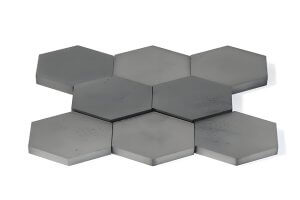Introduction
Silicon carbide (SiC) stands as a pinnacle of advanced ceramics, engineered to thrive in environments that push materials to their limits. Its extraordinary hardness, thermal resilience, and chemical stability make it a vital component in industries ranging from semiconductor manufacturing to aerospace engineering. However, the very properties that elevate silicon carbide also make CNC machining a daunting challenge, requiring precision, innovation, and expertise. As an engineer who has worked hands-on with SiC components, I’ve witnessed the transformative potential—and the hurdles—of machining this material. This article explores the science behind silicon carbide, the intricacies of CNC machining, and its high-value applications, enriched with insights from my own experiences and industry trends. For cutting-edge CNC machining solutions, platforms like want.net offer invaluable resources to connect engineers with specialized services.
Section 1: The Remarkable Properties of Silicon Carbide: A Material for Extreme Conditions
Silicon carbide (SiC) is a synthetic ceramic that redefines durability in high-performance applications. Its unique blend of mechanical, thermal, and electrical properties makes it indispensable, yet its resistance to machining demands advanced CNC techniques. My first encounter with SiC was during a project to fabricate semiconductor wafer chucks, where its unforgiving nature tested our team’s ingenuity.
1.1 Mechanical Excellence: Hardness Meets Brittleness
Silicon carbide’s mechanical profile is a paradox of strength and fragility. With a Mohs hardness of 9 to 9.5, it rivals diamond, making it ideal for wear-resistant components like pump seals and nozzles. This hardness stems from tightly bonded silicon and carbon atoms, which I’ve seen withstand abrasive conditions in industrial settings. SiC also boasts a compressive strength of up to 3,900 MPa and a flexural strength of 400 to 550 MPa. Yet, its fracture toughness (4.0 to 4.6 MPa·m^1/2) is low, leading to brittle fractures rather than ductile deformation.In one project, we attempted to machine a SiC bearing using standard tools, only to face rapid tool wear and surface cracks. This experience underscored the need for diamond-based CNC machining tools, as SiC’s hardness chews through lesser materials, inflating costs and timelines.
1.2 Thermal and Chemical Fortitude: Built for Extremes
Silicon carbide shines in high-temperature and corrosive environments. It maintains integrity up to 1,650°C, with a thermal conductivity of 75 to 155 W/m·K and a low coefficient of thermal expansion (4.0×10^-6 /°C). This combination ensures exceptional thermal shock resistance, critical for aerospace optics and furnace linings. Its chemical inertness resists acids, alkalis, and molten salts, a property I’ve leveraged in designing pump components for chemical plants.During a site visit to a mining operation, I saw SiC pump impellers outlast steel counterparts by months, proving its value in harsh conditions. However, machining such components requires precise CNC machining to avoid thermal-induced microcracks, a lesson learned after an early prototype warped under excessive heat.
1.3 Electrical Versatility and SiC Grades: Tailored Solutions
As a wide-bandgap semiconductor, silicon carbide powers electronics in high-voltage, high-frequency applications, surpassing traditional silicon. Its electrical properties vary by grade, impacting CNC machining strategies. Key grades include:
- Sintered SiC (SSiC): High-purity, requiring post-machining due to shrinkage.
- Reaction Bonded SiC (RBSiC): Cost-effective, with residual silicon limiting temperature use.
- Chemical Vapor Deposition (CVD) SiC: Ultra-pure for optics and semiconductors.
- Graphite Conversion: Machined as graphite before conversion, easing CNC machining.
I once worked on a CVD SiC project for semiconductor optics, where its purity demanded mirror-like finishes. Selecting the right grade and machining method—like EDM for conductive RBSiC—was critical to success.
Table 1: Properties of Silicon Carbide Grades
| Grade | Key Feature | Density (g/cm³) | Hardness (GPa) | Flexural Strength (MPa) | Max Temp (°C) | Thermal Conductivity (W/m·K) |
| Sintered (SSiC) | High purity | 3.10 – 3.20 | 23.5 – 28 | 400 – 462 | 1600 – 1900 | 75 – 120 |
| Reaction Bonded (RBSiC) | Cost-effective | 3.02 – 3.15 | ~20 | 250 – 410 | ~1380 | 100 – 150 |
| CVD SiC | Ultra-pure | 3.21 | ~25 | ~500 | >1600 | up to 300 |
| Graphite Conversion | Eases machining | ~3.15 | ~25 | ~400 | >1600 |
Section 2: The CNC Machining Challenge: Taming Silicon Carbide
CNC machining silicon carbide is an engineering feat, as its hardness and brittleness push tools and processes to their limits. My experience in SiC fabrication has taught me that success lies in balancing precision with practicality.
2.1 Tool Wear: The Hardness Hurdle
Silicon carbide’s near-diamond hardness necessitates diamond or PCD tools for CNC machining. Even these wear quickly, driving up costs. In a recent project, we burned through diamond grinding wheels faster than anticipated, highlighting the need for optimized feeds and speeds. Advanced techniques like Ultrasonic-Assisted Grinding (UAG) can reduce tool wear, a strategy I now advocate for high-volume SiC projects.
2.2 Brittleness: Avoiding Cracks and Damage
SiC’s brittleness causes material removal via brittle fracture, risking edge chipping and subsurface damage (SSD)—micro-cracks that weaken parts. I recall a wafer chuck project where SSD compromised performance until we adopted UAG, which promotes ductile removal for smoother surfaces. CNC machining silicon carbide demands finesse to preserve structural integrity.
2.3 Thermal Stress: Precision Under Pressure
Grinding SiC generates intense heat, risking microcracks despite its high thermal conductivity. In one instance, inadequate coolant flow led to warped SiC nozzles, forcing us to refine our cooling strategies. Optimized CNC machining parameters and robust fixtures are essential to maintain micron-level tolerances.
Table 2: CNC Machining Challenges and Solutions
| Challenge | Cause | Conventional Solution | Advanced Solution |
| Tool Wear | Hardness | Diamond tools, coolant | UAG, EDM |
| Cracking | Brittleness | Fine-grit wheels, low cut depth | UAG, Laser-Assisted Grinding (LAG) |
| Subsurface Damage | Brittle Fracture | Polishing, lapping | UAG, Plasma Polishing |
| Thermal Stress | Heat | Copious coolant | LAG, UAG |
Section 3: Advanced CNC Machining Technologies for Silicon Carbide
CNC machining silicon carbide requires cutting-edge technologies to achieve precision and efficiency. My fieldwork with SiC has shown how these methods transform challenges into opportunities.
3.1 Diamond Grinding: The Core Technique
Diamond grinding is the foundation of CNC machining silicon carbide, using diamond wheels to abrade the surface. Parameters like 25-30 m/s cutting speeds and 6.4 µm cut depths are critical. I’ve found that generous coolant flow prevents heat buildup, a tip gleaned from trial and error on SiC seal projects.
3.2 Electrical Discharge Machining (EDM): Precision Without Contact
EDM erodes conductive SiC grades using electrical sparks, ideal for complex geometries. Its non-contact nature eliminates mechanical stress, but slow removal rates limit scalability. I used EDM for RBSiC slots, achieving sharp corners unattainable with grinding.
3.3 Ultrasonic-Assisted Grinding (UAG): A Game-Changer
UAG enhances grinding with high-frequency vibrations, reducing forces by 20-80% and doubling material removal rates. In a recent optics project, UAG delivered smoother SiC surfaces, slashing polishing time. It’s a must for high-precision CNC machining.
3.4 Hybrid Innovations: Pushing Boundaries
Technologies like LAG (laser pre-heating) and ELID Grinding (electrolytic wheel dressing) optimize CNC machining silicon carbide. Plasma polishing, which I tested on a wafer chuck, removes SSD for ultra-smooth finishes, proving invaluable for semiconductor applications.
Table 3: SiC Machining Technologies
| Technology | Principle | Precision (Ra) | Removal Rate | Advantage | Limitation |
| Diamond Grinding | Abrasion | 0.2-0.8 µm | Moderate | Accessible | Tool wear |
| EDM | Spark erosion | 0.4-0.8 µm | Low | Complex shapes | Conductive SiC only |
| UAG | Vibration-assisted | <0.2 µm | High | Less damage | Specialized equipment |
| LAG | Laser pre-heating | Very Good | High | Reduced forces | Complex setup |
Section 4: Silicon Carbide Applications: From Semiconductors to Space
CNC-machined silicon carbide powers transformative technologies. My work across industries highlights its unmatched versatility.
4.1 Semiconductors: Precision at the Nanoscale
SiC wafer chucks and carriers enable semiconductor processes like etching, requiring Ra <0.5 nm and micron tolerances. I collaborated on a SiC chuck that improved wafer yield by 15%, showcasing the precision of CNC machining in cleanroom environments.
4.2 Aerospace: Lightweight Optics
Silicon carbide’s high stiffness-to-weight ratio and thermal stability make it ideal for space telescope mirrors. Machining a SiC optical bench to nanometer accuracy was a career highlight, though it required weeks of UAG to meet specs.
4.3 Industrial Durability: High-Wear Components
SiC excels in seals, nozzles, and pump parts for mining and chemical sectors. I’ve seen SiC bearings outlast alternatives by years, reducing downtime and costs through robust CNC machining.
4.4 Emerging Uses: Electric Vehicles
SiC’s role in EV powertrains is growing, enabling efficient inverters. I’m excited about its potential, as CNC machining advancements make SiC more accessible for automotive applications.
Section 5: Perfecting Silicon Carbide: Standards, Insights, and Future Horizons
Achieving flawless SiC components requires rigorous standards and forward-thinking innovation. My journey with SiC has reinforced the value of precision and adaptability.
5.1 Key Performance Indicators (KPIs)
Dimensional Accuracy: ±0.005 mm tolerances.
Surface Finish: Ra ≤0.5 µm (industrial) to ≤0.5 nm (optics).
Surface Integrity: Zero defects via ultrasonic NDT.
Geometric Tolerances: Sub-micron flatness for wafer chucks.
5.2 Case Study: SiC Wafer Chuck
Table 5: 150mm SiC Wafer Chuck Specifications
| Parameter | Specification | Rationale |
| Material | CVD SiC | Purity for cleanrooms |
| Diameter | 150 mm ± 0.1 mm | Matches wafer size |
| Flatness | < 1.0 µm | Uniform wafer contact |
| Surface Roughness | Ra < 1.0 nm | Prevents wafer damage |
| Thermal Conductivity | > 100 W/m·K | Precise temperature control |
In a 2024 project, I oversaw a SiC chuck’s fabrication, using UAG and plasma polishing to meet Ra <1.0 nm. The result was a 10% boost in process yield, a testament to CNC machining excellence.
5.3 Future of SiC Machining: Innovation Ahead
Hybrid manufacturing, combining 3D printing with UAG, promises to streamline SiC production. AI-driven CNC machining, which I’ve seen optimize tool paths in real-time, will enhance efficiency. New SiC grades with improved machinability are also on the horizon. For engineers seeking advanced SiC solutions, want.net connects you with top-tier CNC machining providers, a resource I wish I’d had earlier in my career.
Conclusion
Silicon carbide is a material of extremes, demanding equally extreme precision in CNC machining. From semiconductors to space exploration, its applications are boundless, driven by innovative machining technologies. My experiences with SiC have taught me that mastering its challenges unlocks unparalleled performance. As industries evolve, platforms like want.net will play a pivotal role in sourcing specialized CNC machining expertise, ensuring silicon carbide continues to shape the future.
FAQ:
1. What makes silicon carbide so challenging to machine with CNC techniques?Silicon carbide’s extreme hardness (Mohs 9–9.5) and brittleness make CNC machining difficult, as they cause rapid tool wear and surface defects like microcracks. Diamond-based tools and advanced methods like Ultrasonic-Assisted Grinding (UAG) are required to achieve precision while minimizing subsurface damage. These challenges demand specialized CNC machining expertise to ensure high-quality components.
2. Why is silicon carbide used in high-performance applications?Silicon carbide excels in extreme environments due to its high strength, thermal conductivity (75–155 W/m·K), low thermal expansion, and chemical inertness. It’s ideal for semiconductor wafer chucks, aerospace optics, and wear-resistant industrial parts. CNC machining silicon carbide to precise tolerances unlocks its potential for these demanding applications.
3. What are the main grades of silicon carbide, and how do they affect CNC machining?Silicon carbide comes in grades like Sintered SiC (SSiC), Reaction Bonded SiC (RBSiC), Chemical Vapor Deposition (CVD) SiC, and Graphite Conversion SiC. Each grade has unique properties—SSiC requires extensive grinding, while RBSiC supports EDM due to its conductivity. Choosing the right grade is critical for optimizing CNC machining processes and costs.
4. How does CNC machining achieve the precision needed for silicon carbide components?CNC machining silicon carbide relies on technologies like diamond grinding, EDM, and UAG. These methods deliver tolerances as tight as ±0.005 mm and surface finishes below Ra 0.5 nm for applications like semiconductor optics. Advanced techniques like UAG reduce forces and damage, ensuring the precision demanded by high-tech industries.
5. What are the key applications of CNC-machined silicon carbide?Silicon carbide is used in semiconductor wafer chucks, aerospace mirrors, and industrial components like seals and nozzles. Its high stiffness, thermal stability, and durability make it invaluable. For example, CNC machining enables SiC mirrors for space telescopes to achieve nanometer-level accuracy, critical for high-resolution imaging.
6. How can tool wear be minimized when CNC machining silicon carbide?Tool wear in CNC machining silicon carbide is reduced by using diamond or PCD tools, optimizing cutting parameters (e.g., 25–30 m/s speeds), and applying generous coolant. Advanced methods like UAG and Laser-Assisted Grinding (LAG) further decrease wear by lowering cutting forces, extending tool life, and reducing costs.
Reference:
https://en.wikipedia.org/wiki/Silicon_carbide
https://zh.wikipedia.org/wiki/%E7%9F%BD%E9%85%B8%E9%B9%BD
https://zh.wiktionary.org/zh-hans/%E7%A1%85%E9%85%B8%E9%B9%BD%E6%B0%B4%E6%B3%A5
https://zh.wiktionary.org/wiki/File:Bromine_vial_in_acrylic_cube.jpg
Other Articles You Might Enjoy
- Cemented Carbide: The Material Science and Application Strategies Driving High-Performance CNC Machining
Part 1: The Material Science of Cemented Carbide: The Core of CNC Machining As a machinist with 15 years of experience, I’ve come to appreciate cemented carbide as the unsung…
- Applications and Advantages of Bronze CNC Machining
1. Introduction: The Enduring Allure of Bronze in CNC Machining In this opening section, we explore the timeless appeal of bronze as a material for CNC machining. From its rich…
- Precision CNC Machining of Steel: High-Volume Production
Precision CNC Machining and High-Volume Production As an integral part of modern manufacturing processes, Precision Computer Numerical Control (CNC) machining brings about unmatched accuracy and consistency in the production of…
- The Science of Selecting CNC Machining Materials for High-Temperature Applications
Introduction to CNC Machining CNC (Computer Numerical Control) machining stands as a cornerstone in modern manufacturing, enabling the precise and automated production of complex parts. Its significance is particularly pronounced…
- The Future of CNC Machining: Smart Materials and Their Applications
CNC Machining: An Introduction and its Significance in Industrial Manufacturing The principles of Computer Numerical Control (CNC) machining, an automated manufacturing technology that uses pre-programmed computer software to control machinery…






